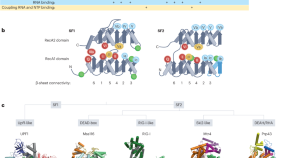Structure–function (original) (raw)
Reviews
Cellular functions of eukaryotic RNA helicases and their links to human diseases
All aspects of gene regulation involve RNA helicases, which bind or remodel RNA and RNA–protein complexes. Recent data establish a link between helicase structure, mechanism of function and biological roles, including in diseases such as cancer and neurological disorders, with implications for the design of small-molecule inhibitors.
- Katherine E. Bohnsack
- Soon Yi
- Markus T. Bohnsack

Pore-forming proteins as drivers of membrane permeabilization in cell death pathways
The proteins apoptosis regulator BAX (BAX), BCL-2 homologous antagonist/killer (BAK) and BCL-2-related ovarian killer protein (BOK), gasdermins and mixed lineage kinase domain-like protein (MLKL) are key executioners of regulated cell death by forming pores across the plasma or mitochondrial membrane. This Review discusses structural rearrangements during activation and oligomerization of these proteins and highlights commonalities and differences of pore formation mechanisms.
- Peter Vandenabeele
- Geert Bultynck
- Savvas N. Savvides

Cellular and molecular mechanisms of Hedgehog signalling
Despite the crucial roles of Hedgehog signalling in development and tissue regeneration, aspects of the Hedgehog signalling mechanism have been uncovered only recently. These studies reveal a central role for lipids in the Hedgehog signal activity, and provide new insights into the therapeutic potential of modulating Hedgehog signalling in tissue regeneration.
- Yunxiao Zhang
- Philip A. Beachy

Structural insights into nuclear transcription by eukaryotic DNA-dependent RNA polymerases
Nuclear transcription of a wide variety of RNA species is conducted mainly by three RNA polymerases, which are large and dynamic protein complexes. Recent structural studies have provided important insights into the activities at different transcription stages and the commonalities and differences between these transcription machineries.
- Mathias Girbig
- Agata D. Misiaszek
- Christoph W. Müller
Comment articles
Embedded within the complexity of biological systems lies a formidable task: deciphering the intricate architecture of macromolecules. In this Viewpoint, a panel of experts discuss the key challenges and opportunities of macromolecular structure determination, highlighting the crucial synergy between empirical experimentation and artificial intelligence-based techniques in unravelling these complexities.
- Xiao-chen Bai
- Tamir Gonen
- Jianyi Yang
